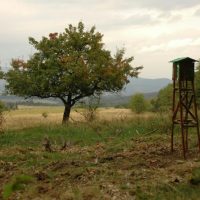Displacement is an everyday experience to this generation. The scholarships and student exchange programs encourage us to learn about the neighbouring cultures and nations and require our integration. It makes us think deeply, due to the dynamism of our connection to the living space.
Pavla Sceranková’s installation of a corner of a room makes us face the uncertainty that we often feel in our temporary living spaces. We can sit into the sliced-up armchair if we are extremely careful, while the reading lamp can be taken apart and joined up again, just like a jigsaw puzzle. Her videos present the completely unusual ways of travel; she rides a giant car on the road or rolls over the exhibition room in a two meter-diameter wheel. Her selected video works and installations are presented at the exhibition.
During his Indian journey, Ádám Szabó created television screens from traditional, hand-made knotted carpets and tin boxes of the local craftsmen. Later, the laptop-sculptures were developed from these screens as essential extensions to the modern human body and brain. These pieces appear as the monuments of life in the exhibition room. Their originals, the peripheral tools still fill our everyday intimate spaces, just like the books, pads and sketches that still exist in spite of predictions.
Dusan Zahoranský’s video installation shows realistic fake birds perching on wires that are hung into the foreground. In his photo series called Mimicry, the artist manipulates reality – the additional objects that he added to open places seem more natural to the human eye than the original photo of the scene.


